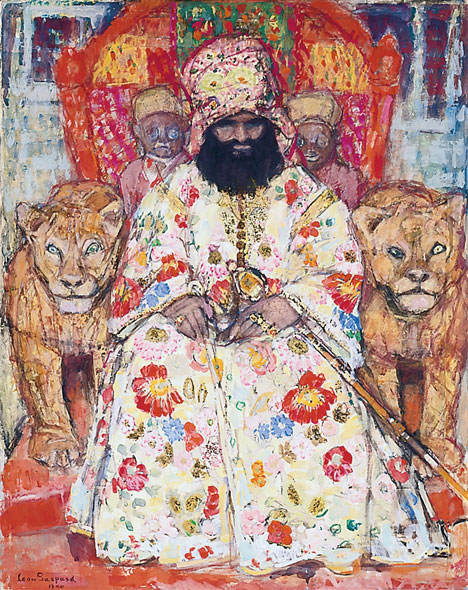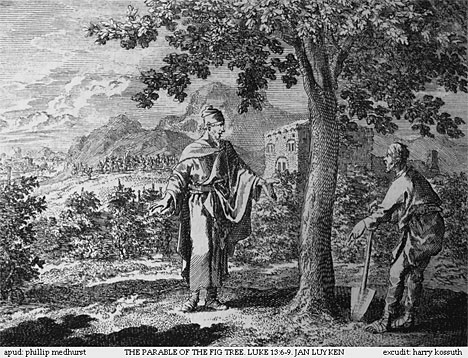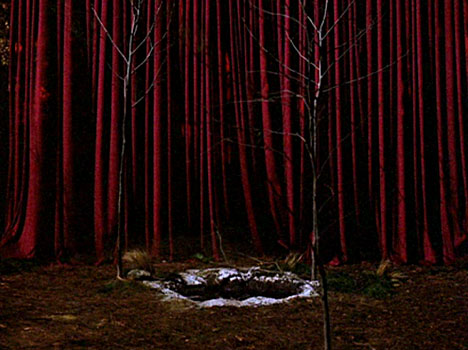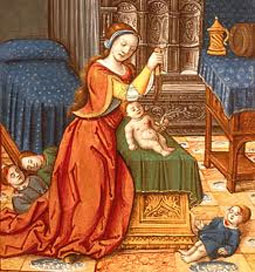Aug
18
2010

“I am the Door.”
The second part of both the Covenant and matrix structures concerns the authority of the transcendent God being delegated to His servant. Very often, a book of prophecy begins with a vision of the Lord, which promptly knocks Adam onto his face as a dead man, and the destroyer passes over him in the darkness. He is “waters divided.” He is called to be separate from the world, and this sanctification begins with mortification. [1] So Psalm 112, as the second in this Covenant song-cycle, concerns the outcome in the world of the faithful use of God’s authority by His Adam.
Comments Off | tags: Passover, Psalms, Solomon, Systematic typology | posted in Bible Matrix, Biblical Theology
Aug
17
2010

Here’s my go at the structure of the first of these seven praise psalms. (The introduction is here.) Apparently, it has five verses, following the Covenant structure. Within this, each stanza also has five lines, which echo the same structure while maintaining the theme of the stanza. The only exception is verse 4 which concerns the Sanctions. It has seven lines. As I maintain, the 5-point Covenant model expands into the 7-point matrix as Ethics gets split into three: Law opened/Death under the Law/Resurrection fulfilling the Law. 5-point Word creates 7-point History. The Sanctions correspond to the Day of Atonement (Conquest) which has the theme of the resurrected body ascending to govern under God. On that Day, every year, Israel died and rose again.
Comments Off | tags: Psalms | posted in Bible Matrix, Biblical Theology, Creation
Aug
16
2010

Psalms 111 to 117 are the “Praise the Lord” psalms, an obvious unit due to the repetition of that phrase. Are they arranged in any order, or is there some internal logic going on? You know what I’m going to say next, don’t you?
Continue reading
2 comments | tags: Fractals, Literary Structure, Psalms | posted in Bible Matrix, Biblical Theology
Aug
14
2010

“Do you suppose that I came to give peace on earth? I tell you, not at all, but rather division.” Luke 12:51
Another weird idea James Jordan presents in his Revelation lectures is the premise that the famous Four Horsemen of the Apocalypse represent the gospel. As Uri Brito wrote a couple of years ago, first you think Jordan is nuts; then, as you continue to study, you think he is less nuts. Finally you give in and accept his genius, because his premise is vindicated by the similar use of the symbols in the Old Testament, and the literary structure of the event.
Continue reading
Comments Off | tags: AD70, Balaam, Herod, John, Literary Structure, Numbers, Revelation, Systematic typology, Zechariah | posted in Bible Matrix, Biblical Theology, The Last Days, The Restoration Era
Aug
10
2010

Part 2 of the Bible Matrix interview on Trinity Talk is now available.
Continue reading
Comments Off | posted in Bible Matrix, Biblical Theology
Aug
9
2010
An Exhortation to Be A Fruitful Tree

Tabernacles was the final annual feast, a Godfest to be thrown by Jews as a ministry to Gentiles. At the Feast of Clouds [1], every household temporarily became a new house of God, a “local branch” of the Tabernacle, a “priesthood of all believers.” Of course, we see this fulfilled in the book of Acts. Just as we see Paul exhort the Ephesians (Gentiles!) to put on the mediatorial body-armour of the High Priest, [2] his final exhortation to the Roman Christians alludes to not only Israel’s feasts but Israel’s priesthood. Pretty much every church he established was a “booth” made of natural Jewish branches and ingrafted Gentile branches. [3] At Pentecost, the same cloud that received Jesus filled the house. [4] Now every household of faith was a Tabernacle, a glorious cloud with a government of human angel-elders. [5] In the Bible’s literary structure, a recurring motif at Tabernacles is good fruit, godly offspring. God wants more than just a covering of leaves. As in Eden, future generations hang upon wise government.
Continue reading
8 comments | tags: AD70, Add new tag, Atonement, Doug Wilson, Feasts, Genesis, Laver, Literary Structure, Paul, Roman Catholicism, Romans, Systematic typology, Tabernacles, Temple | posted in Bible Matrix, Biblical Theology, The Last Days
Aug
4
2010
or Festivals from the Abyss

Herod, when he saw that he was deceived by the wise men, was exceedingly angry; and he sent forth and put to death all the male children who were in Bethlehem and in all its districts, from two years old and under, according to the time which he had determined from the wise men. Then was fulfilled what was spoken by Jeremiah the prophet, saying: “A voice was heard in Ramah, lamentation, weeping, and great mourning, Rachel weeping for her children, refusing to be comforted, because they are no more.” Matthew 2:16-18
Continuing from New Covenant Virility – 2
GLORIFICATION: (Tabernacles feast, marriage, children, rest)
Wow. This last bit really rubs in the kind of offspring (fruit) Israel gave God. It is the seventh stanza of this section, yet in itself it has seven stanzas. Each section submits itself to the common themes in Glorification, yet each section reiterates one step the sevenfold pattern. Tabernacles was the big feast, so in this final ascerbic prophecy, the prophet turns the annual Feasts into curses. [1] What sublime poetry is Isaiah.
Tabernacles is the Feasts of Booths. It is God’s people reaching maturity as a great tree and sheltering the nations. The cycle began with dry trees (eunuchs, etc.) being made fruitful. Here, God lays the ax to the root of the old tree.
Continue reading
1 comment | tags: Altar of the Abyss, Cyrus, Darius, Esther, Isaiah, Solomon, Tabernacles, Un-Passover | posted in Bible Matrix, Biblical Theology, The Restoration Era
Aug
4
2010
A. T. Ross gave Bible Matrix 4 out of 5 stars on goodreads.com:
Continue reading
Comments Off | tags: Adam Ross, Bible history | posted in Bible Matrix, Biblical Theology
Aug
4
2010
 .
.
Some more thoughts on New Covenant Virility.
The minute details of the Bible matter. What was the Ethiopian eunuch, keeper of the queen’s treasure, reading, and why? In sacred history there are no accidents.
Isaiah 53 is about the barrenness and woundedness of God’s Man. He is circumcision epitomised. Like a eunuch, He is judged by men as unfit for Tabernacle service, judged in the gates (kingdom doors shut) and sent outside the city. He is “stricken,” or afflicted with stroke, God’s “lash” of plague, as unacceptable-for-priesthood as a leper.
“…and who will declare His generation?” Here is an important detail. What does this mean?
Continue reading
Comments Off | tags: Abraham, Acts, Athaliah, Baptism, Haman, Isaiah, Literary Structure, Tabernacle, Temple | posted in Bible Matrix, Biblical Theology, The Restoration Era
Aug
3
2010

A lot of very smart Christians believe that the Creation account was written as a foil for Ancient Near Eastern creation myths. It was written by Moses to rally Israel culturally, to set a boundary between the Hebrew identity and that of the nations.
Continue reading
Comments Off | tags: Genesis, James Jordan, Literary Structure | posted in Bible Matrix, Biblical Theology, Creation, Quotes


































